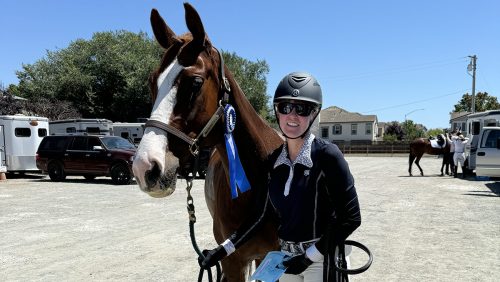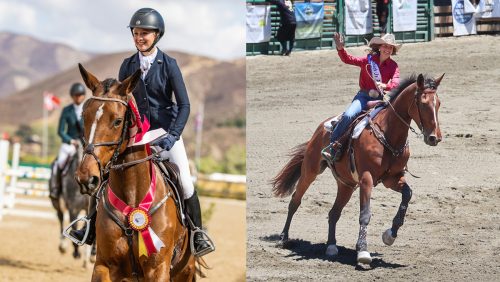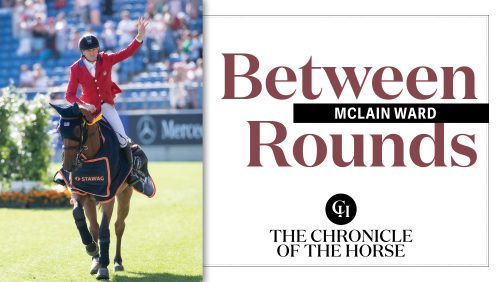With the recent news that Santa Anita Park in Arcadia, California, will again host Olympic equestrian events at the 2028 Los Angeles Games, we’re looking back at the 1984 Olympic Games, a highlight for the U.S. Equestrian Team, with riders earning multiple show jumping and eventing medals in front of an enthusiastic crowd. In 1984, eventing was still run in the long format, and the Fairbanks Ranch Country Club—a site in Rancho Santa Fe, California, that was destined to become a golf course after the Games—hosted the roads and tracks, steeplechase and cross-country course that were required. The U.S. overcame the world champion British team to win gold, and American Karen Stives narrowly missed out on individual gold but became, along with Great Britain’s Ginny Elliott (then Ginny Holgate), the first women to win individual medals in the discipline, while Mark Todd’s diminutive Charisma wrote his name into the lore of the sport. Read John Strassburger’s Chronicle report from Aug. 17, 1984, to relive the excitement.
When the five members of the U.S. Olympic three-day team pulled out of their training camp at South Hamilton, Massachusetts, on July 8, leaving behind coach Jack Le Goff, they put themselves out on a limb. If they came home with the team gold and individual honors, they would look brilliant. It would mean they were experienced international competitors who knew how to prepare their horses. But if they failed, their actions had left them wide open to criticism.
The limb held. The American team of Mike Plumb, Karen Stives, Torrance Fleischmann and Bruce Davidson rode brilliantly to narrowly defeat the World Champion British by 3.2 points, as Stives came within one show jumping rail of being the first woman ever to win the individual gold in the Olympic three-day event. Still, she and Virginia Holgate of Britain, who took the bronze behind Stives and gold medalist Mark Todd of New Zealand, were the first individual female medalists in this discipline.
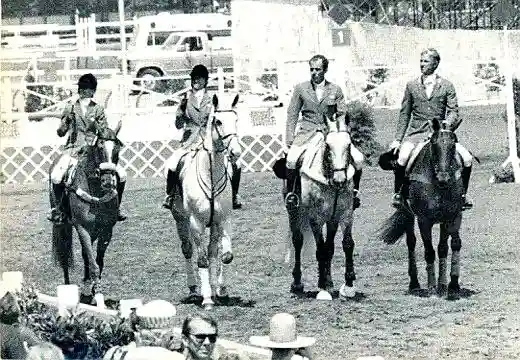
The Americans achieved their victory by becoming a team, something many feared they wouldn’t be able to do after 10 grueling and competitive weeks of trials before the final turmoil. They became a team because they wanted to, because they had to to win.
“I think basically we’re all pretty good friends and we had to do what we had to do,” said team captain Mike Plumb. “We came back from a gallop at Hamilton and decided we couldn’t stay—there was no place to do the conditioning. (Insects were also cited as a problem). We never really sat down and decided to become a team, it just sort of happened after Ledyard. So we met with Billy Steinkraus and decided to leave.”
“We definitely made an agreement that we would all work together.” said Le Goff during the second day of dressage. “We have reached a consensus that we will go for the team medal as a priority. So that means people will ride to orders (on cross-country) according to speed and what is needed.”
Karen Stives concurred. “We’re all out for the team and everything is great with Jack, and that’s no lie,” she said after her dressage test.
So for one week these talented, outspoken and individualistic riders put aside any real or imagined differences, pulled together and did the job they were selected to do.
So for one week these talented, outspoken and individualistic riders put aside any real or imagined differences, pulled together and did the job they were selected to do.
“This one has meant more to me than any other Olympic Games,“ said Plumb, whose gold medal made him the only two-time gold medalist in U.S. equestrian history and raised his total to six, also a record. “Winning the gold here meant more to me than Montreal. We’re a pretty close group, and more than any other time it was a real team effort.”
Cheers From The Crowd
Two days in the heat and smog at Santa Anita racetrack before more than 22,000 mostly partisan fans were really a preview of things to come. The U.S. took a 17.2-point lead over Sweden, the ’83 European Champions. The French, winners at Fontainebleau in 1980, were third, and the co-favored British trailed by 21.8 points. Bruce Davidson, riding fourth on the team, was second with a very forward and accurate test on J.J. Babu and Karen Stives and Ben Arthur were third.
Ben Arthur’s forward and free test, in which he appeared more “connected” than in his most recent efforts, was especially remarkable because he had been feeling full of himself all week and especially when Stives first got on him at 6 a.m. Sunday morning. That early workout was what he needed.
“He was so wonderful from the moment I got on him (to warm up for the test),” Stives said. “At Ledyard (the final trial) I really liked my warmup, but he wasn’t so good in the test, and I was crushed. When we went back to work, he was much better—we’d go through about three good days and then have a bad one. I guess that happens whenever you reach a new level of communication.”
Torrance Fleischmann placed 10th although Finvarra was behind the bit and slightly on the forehand at the trot but lovely at the canter. Plumb was 16th on Blue Stone.
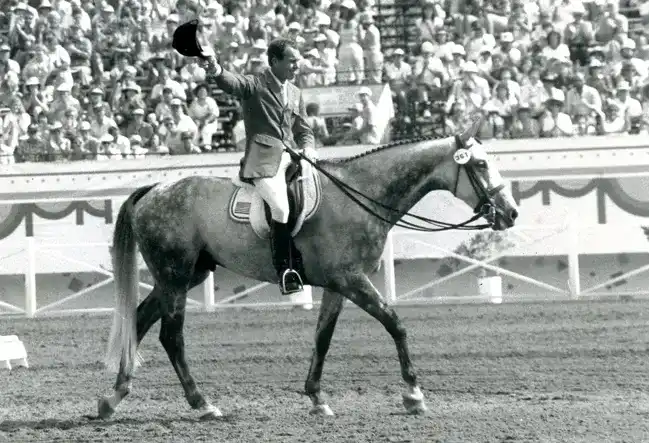
The leader was the lone Swiss rider, the ’81 European Champions, Hansueli Schmutz and the 11-year-old Dutch-bred Oran. The chestnut gelding and his tall, thin rider put in a free and relaxed test in which Oran appeared at times to be above the bit. But this seemed to be what Francois Lucas (France), judge at M, and Anton Buhler (Switzerland), judge at C, wanted because both placed him first with 179 good marks. Lucas had Ben Arthur second at 170, but Davidson sixth and Fleischmann 19th.
Being the leader after dressage was not new for Schmutz. He was in the same position last August at the European Championships on his home turf at Frauenfeld. However, there he began the cross-country course too fast in the unusually hot weather and Oran fell late in the course.
“I rode a terrible cross-country,” Schmutz said after dressage. “I am determined not to make another mistake such as that. I hope I have learned a lesson.”
ADVERTISEMENT
Lurking in fourth place, less than three points behind Davidson and Stives, was New Zealander Mark Todd on the small but courageous Charisma. The pair had beaten the entire British team except Lucinda Green in finishing second at Badminton this April, thus stamping themselves as genuine medal contenders, and now they were well placed before Charisma’s favorite phase.
Brilliance And Luck
As always at an international three-day event, attention focused on the cross-country course, a two-hour drive south of Santa Anita at Fairbanks Ranch. Unlike most international courses, however, the course at the Fairbanks Ranch Country Club had never been ridden before, so riders and coaches weren’t really sure what to expect. Fortunately, assurances that the weather at Fairbanks would be cooler and the air clearer proved true, preventing a repeat of the exhausting conditions at the 1978 World Championships. The almost 4 1/2-mile course criss-crossed the golf course constantly, meaning the path traversed moguls and hillocks designed to add variety to a golf course, not to provide good footing for horses. The riders agreed the fences were beautifully designed and built, but that the track was terrible.
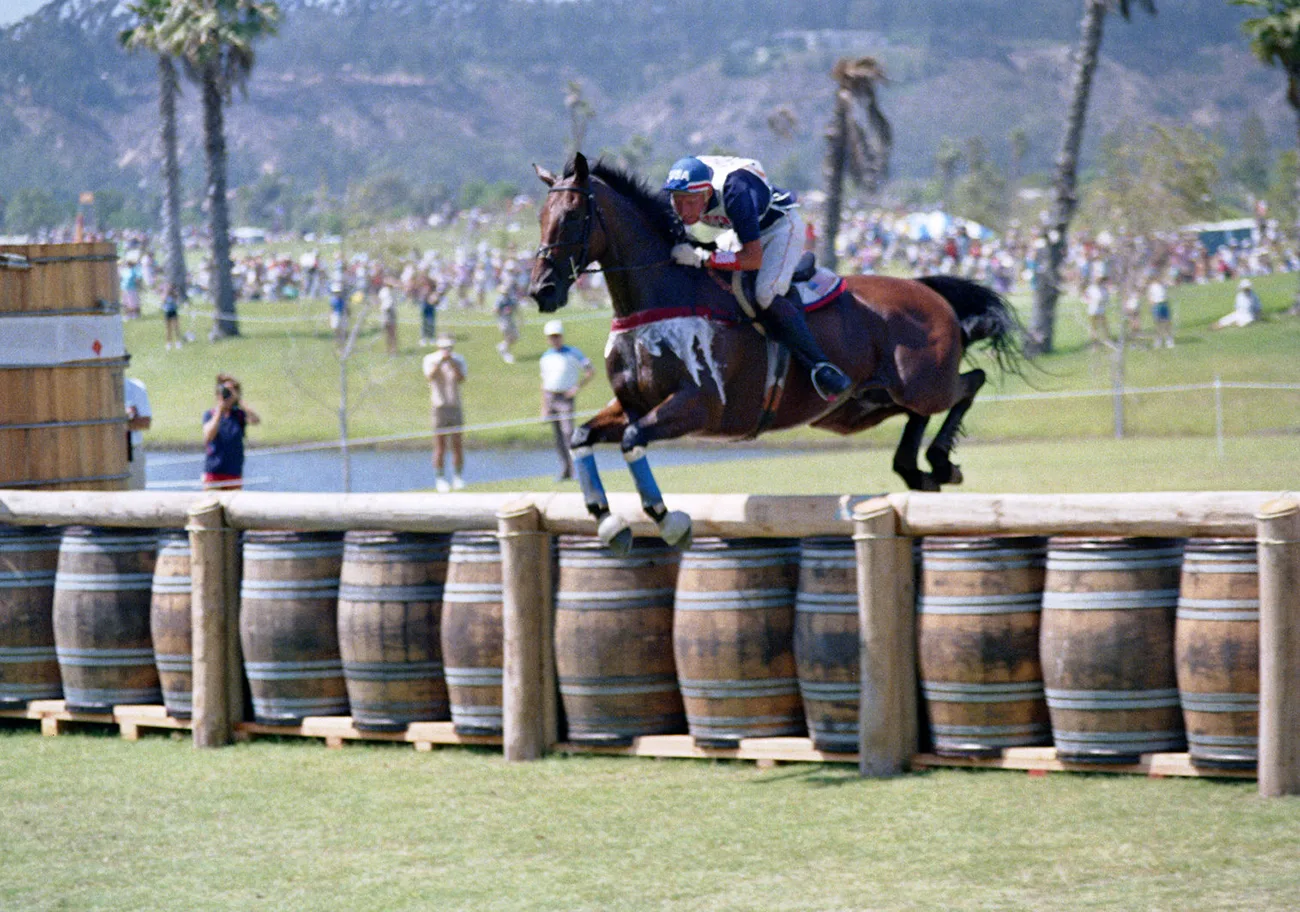
“Olympic courses have not been known to be what they should be—the most difficult courses in the world. I think this one is harder than Montreal and Mexico and on a par with Fontainebleau,” said Plumb. “But the track is not what you’d hope it would be. Because of the hills and the incorrect banking on most of the turns, they never get all four feet on the ground.”
Plumb’s concerns were echoed by World Champion and gold medal hopeful Lucinda Green, who called the course “featureless.” British chef d’equipe Maj. Malcolm Wallace said, “Each fence taken individually is fair, but together it’s a tough test.”
Le Goff predicted that not one would make the optimum time because of the heat and poor footing and that the conditions would favor smaller horses with shorter strides, like J.J. and Finvarra, while hindering bigger horses like Ben Arthur and Blue Stone.
“I think it will require a lot of good sense,” said the coach of 14 years, who will leave on a high note since he is retiring at the end of the year. “My feeling is that once you get to the 10-minute box, you may as well leave your watch behind. You just have to ride what you feel.”
The coach was both right and wrong. Plumb and Blue Stone blazed the trail for the U.S., coming home 13 seconds slow with no jumping faults, despite some rather awkward efforts as Blue Stone appeared to tire. Plumb told his teammates the course was even more slippery than they had thought—he said his horse slipped and almost fell five times—and told them to put in bigger studs. Three horses earlier, the first British rider, Ginny Holgate on Priceless, had shown it might be possible to make the time. The big-boned English-bred finished only 1 second slow with a truly priceless performance. But not until Ben Arthur, the 17th horse on course, was there a clear round. Only three more horses—Regal Realm, Charisma and Master Hunt (Marina Sciocchetti of Italy)—would go clean, with Charisma the fastest. In a way, Ben Arthur’s near-perfect performance shouldn’t have been too surprising since he had gone the best under the most difficult circumstances this spring. The gray Irish-bred was the only horse to make the time over Ship’s Quarters’ twisting and undulating course and had the fastest time over the rain-sodden course at Green Spring Valley. With his long, effortless stride and great scope, Ben Arthur met every fence at Fairbanks perfectly, faltering only on landing in the first pool at The Waterfalls.
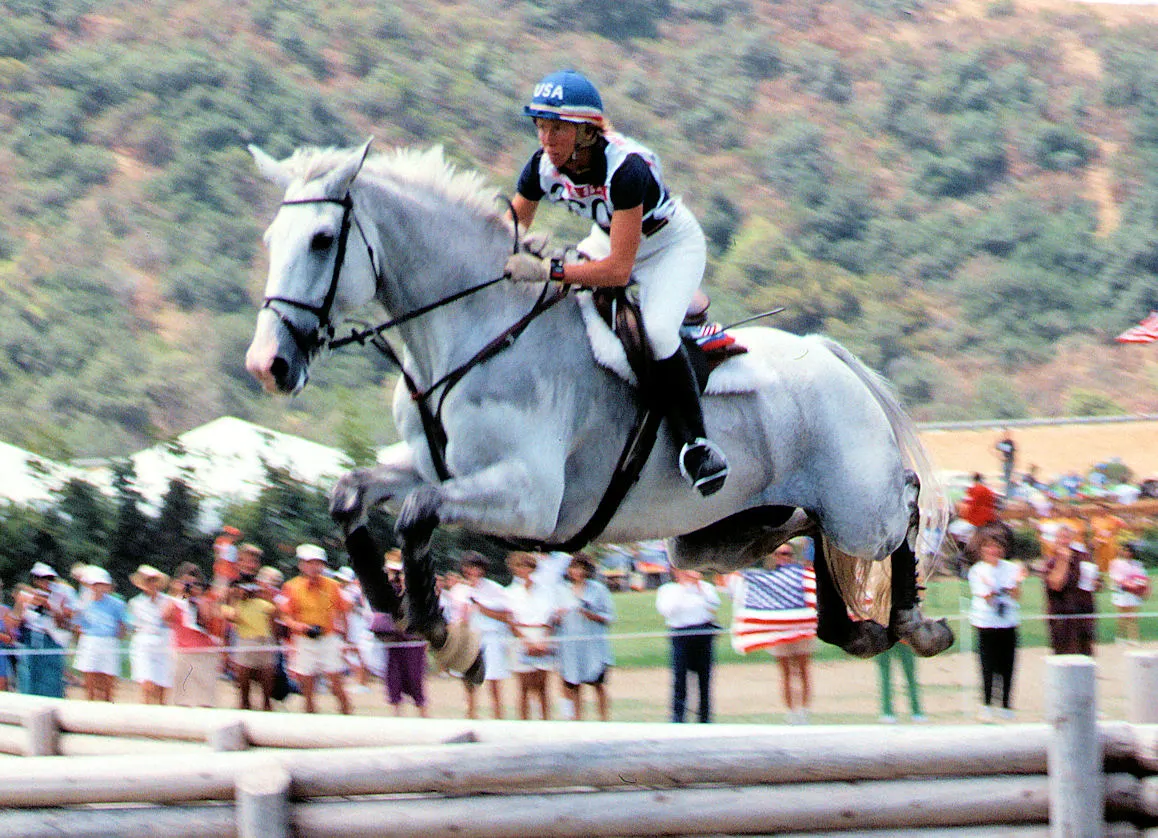
“It rode much better than I thought it would,” said Stives. “He handled the turns really well—just like a slalom skier. But he never gives me a feeling he can’t handle it. He’s always solid.”
Stives’ mother, Lillian Maloney, was proud of both her daughter and the horse that Maloney picked at the World Championships in Luhmühlen barely two years ago. Although not a horsewoman, Maloney has an uncanny eye for equine talent—she also picked Stives’ former star The Saint—and at Luhmühlen she told Stives to get first refusal on Ben Arthur despite Stives’ protests that he was too big and difficult in show jumping. On Wednesday, Aug. 1, despite the anxiety she now feels since Stives’ horrible fall at Kentucky in 1982, Maloney had reason to believe her stars were going to do well.
“I was out on the course before Karen went and I met this movie star—what was his name?” she asked her husband, Bob, at the final vet check on Thursday morning. “William Devane, that’s right. He told me. ‘I’ve already picked the gold medal.’ and I said, ‘Oh really? Who?’ He said, ‘Karen Stives, she has the best horse.’ Then he wouldn’t believe I was her mother!”
Stives was saying that second wouldn’t be so bad, but her mother was thinking gold even though Ben Arthur was less than a rail in front. “I blame my friend Jack Burton for this,” she said with a smile, pointing to the dressage scores. Gen. Burton had placed Charisma first with 173 good marks (to 147 and 142 from the other judges) while giving Ben Arthur 157. Meanwhile, the British were hanging tough, as 30-year-old Ian Stark, representing Britain for the first time, got around with 7.2 time faults. However, their third rider, Diana “Tiny” Clapham on Windjammer, fell at fence 7.
The U.S. only had a little breathing room, though, when Torrance Fleischmann rode into the vet box on Finvarra. Only a week before, Finvarra had hit his head on a screw eye in his stall and given himself a hairline fracture of his skull near the right ear. Now the gallant chestnut, competing in only his fourth three-day event, was tied up. Under normal circumstances. Fleischmann wouldn’t have gone, but this was the Olympics. Her husband, Charlie, got Finvarra past the vet inspection by “falling on my face” to distract the judges while he jogged the horse. Finvarra spooked and judges asked to see him again, but he had loosened up enough to pass. Finvarra had no jumping faults, although Fleischmann had to hit him for the first time in his life and finished 7 seconds slow. The next morning Fleischmann had high praise for the work team veterinarian Marty Simenson and Finvarra’s groom, Debbie Furnas, had done, but she didn’t know whether to tell the whole world how brave her horse was or to be ashamed of herself for making him go.
“He really showed me something yesterday,” she said with emotion. “He’s the bravest horse I’ve ever ridden. I was really just riding the horse, not the course, out there. Now I know what it means to ride in the Olympics—riding a horse that’s not 100 percent and giving it everything you have.”
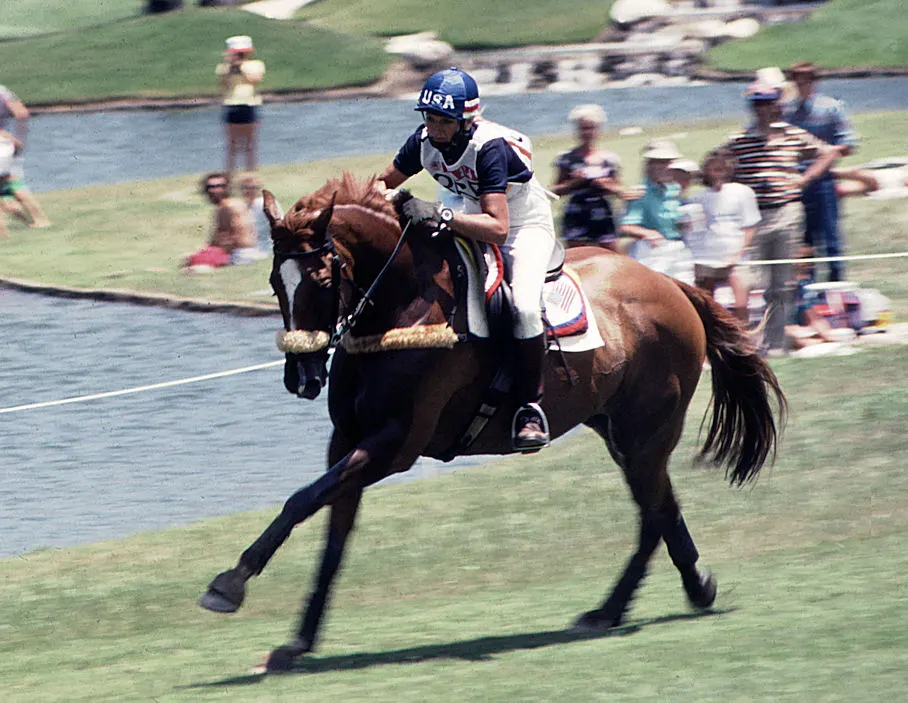
Britain’s final combination, Green and Regal Realm, came through with their usual flawless cross-country performance to keep the Brits close. Then, Bruce Davidson entered the starting box with a chance to take the individual lead and keep the U.S. comfortably in front. Leader Hansueli Schmutz had had a refusal at fence 7, the Bridge and Walkway, where horses jumped down a small bank into a pond, up onto a 9-foot-9-inch-wide bridge, over a 3-foot 5-inch rail back into the water, and up a bank to exit.
Number 7 was the course’s bogey fence. Stives said it was like doing a gymnastic combination—either it worked out or it didn’t. It worked out beautifully for Ben Arthur and Charisma, but not for Oran or J.J. Babu. The American horse jumped in big, slipped, made a big leap onto the bridge, and found his chest against the rail. Davidson calmly turned him around, tried again and continued.
“He jumped into the first pool like he thought it was really deep,” Davidson said. “It was like going down into your basement with no lights and looking for the floor—and not finding it.”
Davidson bristled at the suggestion that there was something wrong with J.J. Babu because this was his third refusal in the last year, the others being at the Trout Hatchery at Burghley (England) last September and at the Coffin at Kentucky this May.
ADVERTISEMENT
“I don’t think there’s anything wrong with him,” Davidson insisted. “There’s an explanation for each refusal. They’ve all been on great, big courses that caused lots more trouble than that. J.J. still has all my confidence.”
Nevertheless, because of bad luck the one title Davidson has not won had again eluded him and the U.S. was less than two rails ahead of Great Britain with one phase to go.
One Gold Gained, One Lost
For the first time in Olympic history, show jumping was conducted in reverse order of placing, meaning the pressure and excitement had a long build-up since three of the four British and all four Americans were in the final 15 of the 40 riders. The three of the four young riders on the German team (all were under 30 and two were 21) went clean to hold on to third place, a finish they and their coach, Bernd Springorum, were thrilled with. Davidson pulled a rail, as did Plumb, narrowing the U.S. lead to less than a rail. Stark pulled a rail, but Green delivered a clean round, and Fleischmann responded likewise despite Finvarra’s previous problems and a case of food poisoning she contracted on Thursday. Holgate then went clean to clinch at least an individual bronze and a team silver, and Todd and Charisma went clean despite touching almost every fence, as he had at Badminton.
“That’s a little trait of his. He likes to feel his way around the course. It’s a little nerve wracking,” Todd joked later.
Two gold medals were up for grabs as Stives and the athletic Ben Arthur cantered into Santa Anita’s stadium to a deafening roar. Pockets of applause broke out and were quickly quieted as they cleared the first 10 fences. But Ben Arthur jumped flat in the triple combination and pulled the middle element. The individual gold belonged to Mark Todd, but by keeping the last fence up, Stives kept the U.S. in front for the prize all four riders said they really wanted.
Watch Stives silver-medal-winning round:
Stives was asked later what she thought when the rail fell. “Not to have another one,” she quickly replied. “The only real pressure was for the team, and I knew we had only one rail, so I wasn’t devastated. I think the silver medal is terrific, and I never expected it. I’m a born pessimist, and when I don’t expect things, they mean more.”
For Todd, 27, becoming the first equestrian medalist in the history of New Zealand had been a long road. His first international event was the 1978 World Championships in Lexington, and since then he has trained on and off in England. In 1980 he won Badminton on the New Zealand-bred Southern Comfort, whom Torrance Fleischmann bought and rode in the 1982 World Championships. In 1983 he finished ninth at Badminton on Felix Too, whom he’d only ridden a few weeks. This March he returned to England, “primarily to have a go at Badminton and to have a go at this. But I think we’ve been preparing for this much longer,” he reflected.
Charisma, who turned 11 during the games because New Zealand horses celebrate their birthdays on Aug. 1, had a varied career before being united with Todd 18 months ago. He show jumped and evented before being shown Prix St. Georges by Jenifer Stobart, a Chronicle correspondent and former riding instructor at the Foxcroft School in Middleburg, Va. With Todd, the agile and quick brown gelding won three New Zealand events before finishing second at Badminton. Todd was asked several times whether Charisma would be for sale after the Games, but he said the horse’s owners, his sponsor Woolrest International and Mrs. Fran Clark, had not yet decided. The individual medal ceremony was loud and moving, but not nearly as emotional as the team awards. The crowd of over 28,000 began to cheer as soon as the special Olympic anthem ended, before they could even see the American horses in the tunnel. And when they appeared, everyone was swept up in euphoria. After years of training and months of competition and controversy, they had finally done it. And at home, which made it even better.
I think it’s the best national anthem in the world, and everybody has to stand and listen to it.”
Bruce Davidson
“I don’t like to cry, but it entered my mind,” said Mike Plumb.
“And he does cry a lot,” said Bruce Davidson. “It was like a dream come true. I think it’s the best national anthem in the world and everybody has to stand and listen to it.”
“I think about all the people who made it possible, without whom I—none of us would be here,” said Torrance Fleischmann. “It’s going to pull the heart strings every time. It’s a dream I’ve had since I was a little girl.”
“They’ve said it all,” said Karen Stives, before adding, “The best thing is everything is over, and we won the gold. I feel relieved.”
This article originally appeared in the Aug. 17, 1984, issue of The Chronicle of the Horse. If you’re just following COTH online, you’re missing so much great unique content. Each print issue of the Chronicle is full of in-depth competition news, fascinating features, probing looks at issues within the sports of hunter/jumper, eventing and dressage, and stunning photography.






